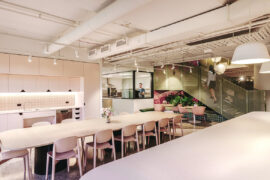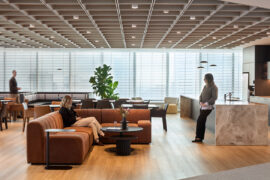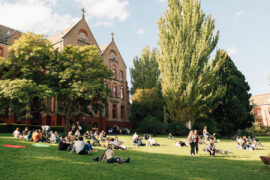Can curiosity encourage movement in the workplace? Wilkhahn’s new Metrik chair plays with the typology of the cantilever to grab attention and invite engagement.
“I’m so tired,” we often think after a day in the office. And we wonder why that is because we don’t move around that much during the day.
One of the biggest dangers present in the working world today is a lack of movement coupled with mental exhaustion. “The normal bodily reaction to mental stress is maximum physical activity, but if you’re restricted in your movement, that’s when health problems emerge,” says Burkhard Remmers, Wilkhahn’s Director of International Communication and Public Relations.
Alas, most days we shift between two operating modes: desk jockey and couch potato.
Wilkhahn creates office furniture that promotes physical activity, and its new chair Metrik shows one of the less obvious ways to do so – by inspiring curiosity. “Curiosity is a motivation to move,” says Remmer, pointing out that people are curious by nature and that fascinating objects can animate them to engage.
Metrik – Wilkhahn’s contemporary interpretation of a cantilever chair – was created to inspire fascination and to allow for small movements while it is being used (through the characteristic bounce of the cantilever). Designed by Germany-based studio whiteID, Metrik catches the eye with a distinctive silhouette that feels familiar and curiously new.
Since the cantilever chair emerged in mid-1920s, it has become one of the most recognisable chair typologies, based on a load-bearing tubular steel structure to which seat components are attached. Metrik breaks with that tradition; it was conceived as a sculptural monolith whose seat, backrest and arms appear to be fused with its steel frame.
“We wanted a chair that looks like a sculpture made out of a volume of material,” says whiteID designer Andreas Hess. “It’s as though you’ve gradually taken away material, and in the end you have this sculpture,” he explains. Not surprisingly, Hess likens the design process for Metrik to automotive design, for which whiteID is well known.
The design team conducted rigorous ergonomic studies to ensure the chair would be able to support the body’s weight comfortably while having enough ‘give’ to flex and move. The thickness of the component parts varies to optimise strength and flexibility, and to simultaneously keep the weight of the chair as low as possible.
“After we optimised the structure and comfort, we looked at the design from the outside – how should it be shaped so that it can exist in different contexts and architectural surroundings?” recalls Hess. Metrik features polygonal shapes and rounded edges that bring to mind the parametric design methods in both the architectural and automotive industries.
With Metrik, Wilkhahn plays with a classic chair typology and tackles the similarity we see in much workplace furniture head on. Hess sums it up: “It’s part of the Wilkhahn culture to be brave enough to do new things.” Metrik is available from Q1 in 2017.
INDESIGN is on instagram
Follow @indesignlive
A searchable and comprehensive guide for specifying leading products and their suppliers
Keep up to date with the latest and greatest from our industry BFF's!
The new range features slabs with warm, earthy palettes that lend a sense of organic luxury to every space.

Gray Puksand’s adaptive reuse of former Melbourne office into Hester Hornbrook Academy’s new City Campus shows how architecture can support wellbeing, connection and community.

GroupGSA delivers MUFG Pension & Market Service’s Sydney HQ with a dual Japanese–Australian identity, blending precision, warmth and workplace flexibility.
The internet never sleeps! Here's the stuff you might have missed

Abbotsford Convent has appointed Kennedy Nolan to guide the next stage of development at the heritage-listed Melbourne precinct, continuing its evolution as a cultural and community landmark.

Carr’s largest residential project to date integrates concrete, steel mesh and landscape across 122 apartments in Melbourne’s Brunswick.